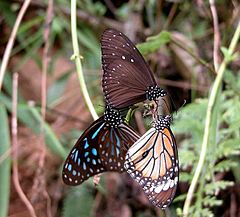- Milkweed butterfly
-
For the mythological fifty daughters of Danaus, see Danaides.
Milkweed butterflies 
Three Milkweed butterflies Scientific classification Kingdom: Animalia Phylum: Arthropoda Class: Insecta Order: Lepidoptera (unranked): Rhopalocera Family: Nymphalidae Subfamily: Danainae Tribes - Danaini
- Tellervini
- Ithomiini
- but see text.
Synonyms - Danaidae
Milkweed butterflies are a subfamily, Danainae, in the family Nymphalidae, or brush-footed butterflies. They lay their eggs on various milkweeds on which their larvae (caterpillars) feed. Historically, this group had been considered a separate family, Danaidae, and the tribes placed herein were sometimes considered distinct subfamilies in the Nymphalidae.
There are some 300 species of Danainae worldwide. Most of the Danaini are found in tropical Asia and Africa, while the Ithomiini are diverse in the Neotropics. Tellervini are restricted to Australia and the Oriental region. Four species are found in North America: the Monarch Butterfly (Danaus plexippus); the Queen (Danaus gilippus); the Tropical Milkweed Butterfly (Lycorea cleobaea); and the Soldier Butterfly (or "Tropic Queen"; Danaus eresimus).
The best known member of this family is the Monarch butterfly. The larvae and the butterflies retain poisonous glycosides from their larval host plant, the milkweed, so they become distasteful to potential predators. These milkweed butterflies (Monarch, Queen, Soldier) eat only milkweeds (Asclepias) as larvae. This highly effective defense strategy shields them against almost all predators that soon learn to avoid these species after attempting to eat them.
Another member known especially for its presence in butterfly greenhouses and live butterfly expositions is the Southeast Asian Idea leuconoe.
Contents
Characteristics
Some authors classify this family as a subfamily of Nymphalidae. Many other authors accept the traditional classification of Danaidae as a separate family. This separation is based on similarity of early stages, similar habits and poisonous nature.
Features include:
- Small to large size butterflies. Most are not brightly coloured
- Forelegs modified in to brushes and are not suited for walking
- Sex marks appear on the wings of most males, either as patches on the hindwing or one or two brands on the forewing or with sex brand patches on either fore or hind wing. In some Euploea males the dorsum of forewing bowed and in females it is straight
- Most Danaidae males have one or two pairs of anal hairs or pencils
- Most of the members are model of 'mimetic' butterfly species of other families.
- Danaids are poisonous and left alone by birds and other natural predators.
- Danaids are extremely tough and hard to kill
- Take part in migration
- Food plants belongs to Asclepiadaceae, Apocynaceae, and Moraceae.[1]
Threats
Numerous wasps are parasitoids of milkweed butterfly caterpillars.
The extensive modification of landscapes in the United States and Canada, with the removal of roadside weeds that are butterfly host plants and the large-scale use of pesticides, and increased deforestation in Mexico, threatens the migratory Monarch butterfly.
References
- ^ Aluthwattha R.G.S.T. (2009) http://www.butterfliesandmoths.net/Family_Danaidae.html[dead link]
External links
- Milkweed Butterfly large format closeup photographs Cirrus Digital Imaging
- Danaid[dead link]
- Danainae
- Highway shut for butterfly travel

This Danainae article is a stub. You can help Wikipedia by expanding it.
